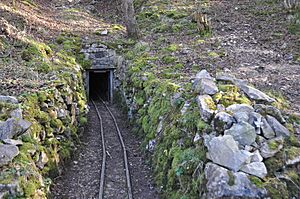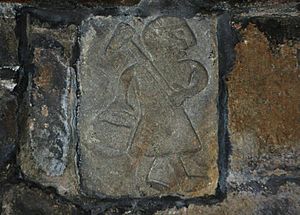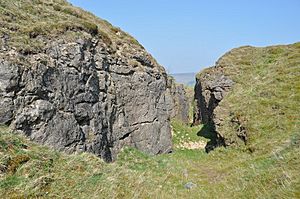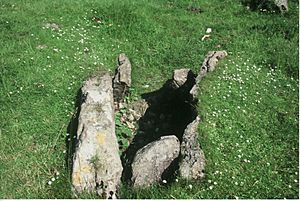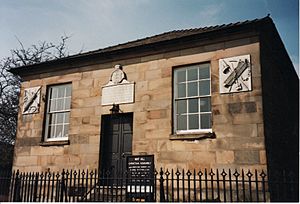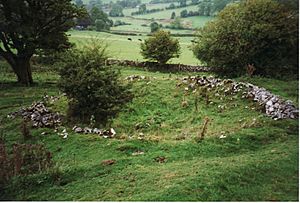Derbyshire lead mining history facts for kids
This article explores the exciting history of lead mining in Derbyshire, England. For hundreds of years, lead mining was a super important industry here. It shaped the lives of many people and helped build the country!
Contents
The Story of Lead Mining in Derbyshire
People have been mining lead in Derbyshire for a very long time. Some say that Odin Mine, near Castleton, might have been used as far back as Roman Britain! We know for sure it was busy in the 1200s. Old records from the 12th century, called the Pipe Rolls, even mention Derbyshire lead mines.
Scientists found lead in ice from Switzerland that shows how much pollution was in the air between 1170 and 1216. The levels were as high as during the Industrial Revolution! This lead likely came from the Peak District mines, which were a major source of lead in Europe back then.
Inside Wirksworth Church, you can see an old stone carving. It shows a miner carrying a basket and a pickaxe. This carving is from Anglo-Saxon times and reminds us that people in Wirksworth depended on lead mining for centuries. You can also see a fancy tomb for Ralph Gell, who died in 1563. He became very rich and powerful from the lead trade.
While some people like Ralph Gell got wealthy, for many families, mining was a tough way to make a living. It was dangerous work. Miners faced risks like poisonous lead dust, floods, falling rocks, and dangerous gases. Later, gunpowder made it even more risky. But despite the dangers, thousands of mines were dug, showing how much lead was taken from the ground.
By the 1600s, lead was the second most important product in England, after wool. It was used for roofs on big buildings and new houses. Windows had lead frames, and lead was the only material for water pipes and storage. Armies used it for ammunition. There was a big demand for lead both in England and from other countries. The Wirksworth area was the main place where this important metal came from.
Wirksworth was also a key place for local government. The mining area of Derbyshire was called the King's Field, because the king owned the lead ore. This area was split into two parts, and then into smaller "liberties" based on local areas. Wirksworth was in the Low Peak part of the King's Field.
Lead mining had always happened around Wirksworth. This area has lots of limestone, which contains rich deposits of galena, or lead ore. The Romans mined here and left behind lead ingots (blocks). In the 800s, a monastery owned mines in Wirksworth. After the Norman Conquest, the mines stayed under royal control. The Domesday Book from 1086 even mentions the mines in Wirksworth and Bakewell.
How Miners Found and Dug Lead
Miners used to find lead by following veins that showed on the surface. But by the 1600s, most of this easy-to-find lead was gone. So, miners had to get clever. They looked for signs in the ground, like certain plants or poor crops, because lead is poisonous. They also used probes to check the soil and dug small holes to find promising spots.
Miners dug shafts, which are like deep holes, in sections. They climbed up and down using footholes or wooden steps called stemples. This was very tiring and dangerous! These climbing shafts were usually inside a small stone hut called a coe, where miners kept their tools and food. If a mine was on a hillside, they could sometimes dig a tunnel called an adit straight into the slope.
To bring the ore to the surface, they used a winding shaft outside the coe. Their tools included picks, hammers, and wedges to break the rock. They used wiskets (baskets) and corves (sledges) to move the ore to the bottom of the shaft. Then, they used windlasses or stows (like big winches) to lift it up. Later, they used wagons on wooden or metal rails underground, which made transport easier. You can still see an old wooden railway in the Merry Tom mine near Via Gellia.
Miners tried to avoid digging through hard rock. If they had to, they sometimes used a method called fire-setting. They would build a fire against the rock face at the end of the day and let it burn all night. The heat would crack the rock, and throwing water on it would break it up even more. This was a skilled and dangerous job because of the smoke and splintering rock.
New Ways to Process Lead
After a quiet period in the mid-1500s, lead mining picked up again thanks to new technologies. The way ore was prepared and smelted (melted to get the pure lead) changed a lot.
Old Smelting: Bole Smelting
The old way of melting lead was called bole smelting. This involved building a large fire on a hill and letting the wind blow through it. It worked best with big pieces of rich ore called bing. Smaller pieces of ore couldn't be used, so lots of lead was wasted. Bole smelting also needed two days of strong wind, so it could only be done when the weather was right.
New Smelting: Smelting Mills
In the late 1500s, people stopped relying on wind. They started using smelting mills. These mills used bellows (like giant air pumps) to create a strong blast of air for the furnace. At first, the bellows were powered by foot, but later, they used water power.
These mills burned "white coal," which was actually kiln-dried wood. Wood was preferred for the main furnace because it didn't get too hot. Drying the wood also stopped smoke, which helped the smelters see what they were doing. Charcoal was used in a second furnace to re-melt the leftover slag (waste) from the first furnace, as this needed more heat.
Preparing the Ore: Dressing
Before miners could sell their ore, they had to "dress" it. This meant separating the lead ore from the rock and washing it. For the new smelting mills, the ore was crushed into small pieces, about the size of peas. This was done by hand with a hammer called a bucker, or in bigger mines, by a horse pulling a roller around a paved circle.
Crushed ore was then washed. One way was to run water over it in a sloping trough called a buddle. Another way was to put it in a sieve and plunge it into a trough. In both methods, the heavier lead particles would sink, and the lighter, unwanted minerals would be skimmed off. These steps were repeated at the smelter to get very pure lead.
Mining Rules and Customs
The lead industry had special rules based on the ancient idea that the king owned all the minerals. These rules were designed to help the Duchy of Lancaster (a royal property) collect the king's payments, called royalties. The local person in charge of these rules was called the barmaster. He ran the industry with help from deputies and miners' juries in the Barmote Court. Even though lead mining is mostly gone, the barmaster and jury still meet in the Barmote Hall in Wirksworth to keep the traditions alive.
The king wanted to encourage lead mining, so he created "free mining" rules. This meant that any man who found a good amount of ore could open a mine and keep it as long as he worked it. Also, mining was more important than land ownership. Landowners couldn't stop mining, even if it damaged their land. Of course, this caused arguments! For example, in 1620, farmers complained that mining was poisoning their cattle. But usually, the miners managed to keep their rights. These customs allowed ordinary families to make a living without working for farmers.
The Barmaster and the Jury
The chief barmaster was a wealthy and important person who oversaw the whole mining area. He had a lot of power and earned a good income. He often attended the Barmote Court meetings, where disputes were settled.
The Barmote Court also had a jury of 24 men. These jurors were chosen because they knew a lot about mining. They helped make fair decisions in arguments and trials.
Deputy Barmasters
The chief barmaster appointed deputy barmasters. These were experienced local men who actually ran the day-to-day system. They decided who could have a mine and who might lose one. They also kept records of mine ownership, how much ore was produced, and the payments collected.
When ore was brought out of a mine, it was measured. The barmaster collected every 13th dish of ore as a royalty, called lot. Merchants who bought the ore from miners paid an extra fee called cope. Deputy barmasters used special knives to mark the number of dishes on a stick as they were measured. Many of these old records still exist today!
Claiming a Mine
To get permission to work a mine, a miner had to show the barmaster that it had enough ore to be worth digging. This was proven by filling a standard container, called a dish, with about 65 pounds of ore from the mine. Once approved, the miner was said to have "freed" the mine. They were allowed to work a certain amount of ground, called "meers." A meer was about 29 yards long in the Wirksworth area.
Because lead veins could twist and turn underground, miners often argued about who owned which part of a vein. Sometimes these arguments even led to fights!
Keeping Records and Ownership
Deputy barmasters also settled arguments over ownership and could stop mines from operating until a decision was made. They could take away a mine's ownership if it wasn't being worked. They regularly checked mines and would "nick" the wooden supports (stows) at neglected mines. If a mine got three nicks over three weeks, its ownership could be given to another miner. This rule made sure miners kept working their mines.
Pollution from Mining
Lead is harmful to both plants and animals. The smelting process was especially dangerous for people. There's even a lane near an old smelter called Belland Lane, and "belland" was a name for lead poisoning. Today, owners of old mine sites sometimes plant trees to turn farmland into woodland, to avoid harming crops and animals.
People have known for centuries that washing ore could pollute water. Farmers and miners often argued about this. In the 1680s, Sir John Gell II said that washing ore could poison cattle.
In 1794, some miners were taken to court for polluting the River Derwent. Witnesses said the river was muddy for miles. A pub owner in Matlock couldn't use river water for brewing anymore and had to dig a well! The miners argued that custom allowed them to wash their ore. But the court ruled against them, saying they should put the sludge in a special area to prevent pollution.
To try and stop pollution, trees were sometimes planted along lead veins to keep cattle away. Smelting mills also had chimneys to spread out the fumes, but this wasn't always successful, especially if the mills were near towns. The mills also polluted the streams that powered them. Later, new furnaces called cupolas had long tunnels to carry fumes far away before releasing them.
Draining the Mines
For a long time, mining stopped when miners hit the water underground. Horse-powered pumps didn't work very well. But later, mines were drained using water, steam, and even electricity. The first big success came from soughs (pronounced "suffs"), which were long drainage tunnels dug into flooded areas to let the water flow out.
These soughs changed the industry by lowering the water level and opening up huge new areas of lead ore. The very first sough was designed by Sir Cornelius Vermuyden and finished in 1652. It immediately caused a big jump in lead production. Many more soughs followed, leading to a dramatic increase in lead mining in the Wirksworth area.
One important sough was the Cromford Sough, dug between 1662 and 1696. It even provided power for Richard Arkwright's famous cotton mills in Cromford, which were built starting in 1771.
The Meerbrook Sough, started in 1772, eventually drained most of the Wirksworth area. It's a huge tunnel, 10 feet wide and 8 feet high! It still discharges millions of gallons of water every day. By the 1830s, it had reduced the water flow from the Cromford Sough so much that Arkwright's mills had to close.
New Smelting: The Cupola Furnace
The smelting mills that replaced the old bole fires in the late 1500s were themselves replaced in the 1700s by a new type of furnace called the cupola.
The old mills had problems. They often overheated and released lots of pollution, so they had to be shut down every day. Their hearths (the part where the fire was) wore out quickly and needed constant repairs. Also, they had to be built next to rivers for water power, and they needed a lot of wood, which was becoming scarce. If they used coal, it added impurities to the lead. Plus, they weren't as efficient as the cupola.
The cupola was a different kind of furnace. The fuel (like coal) was burned in a separate chamber from the lead ore. This meant the ore didn't get contaminated by the fuel. The flames and hot gases from the fuel were drawn over the ore by the chimney's draft. The heat bounced off the low, arched roof, melting the lead.
Cupolas were much better than the old mills. They could run continuously, without stopping. Less lead was lost because the airflow wasn't as strong, and no lead was lost into the ash since the fuel and ore were separate. Also, cupolas didn't need water power, so they could be built anywhere. However, melting the leftover slag still needed water power, so most cupolas were still built near rivers. Many cupolas also had long tunnels to trap pollutants before they went into the air. The metal dust collected in these tunnels could even be re-melted!
The End of Lead Mining
The Derbyshire lead industry started to decline after the late 1700s. This was because many veins were worked out, costs went up, and cheaper lead was found in other countries. For a while, taxes on imported lead helped protect the local industry. But when these taxes were lowered in 1820 and removed in 1845, it led to a big increase in imported lead and sped up the decline of local mining.
There were still some good years. In 1862, a mine in Brassington, an area that usually didn't produce much, mined over 650 metric tonnes of lead! One mine owner said they had finally found "the long sought for treasure" and hoped to keep employing over 100 men. However, by 1901, only 285 men worked in all the Derbyshire lead mines. Most of them worked at the Mill Close Mine near Darley Bridge.
Mill Close was the biggest lead mine in the country and kept the Derbyshire lead industry going into the 20th century. Just before it had to close in 1939 due to flooding, it employed about 600 men. The smelter at Mill Close was bought by a London company in 1941 and is still operating today.


